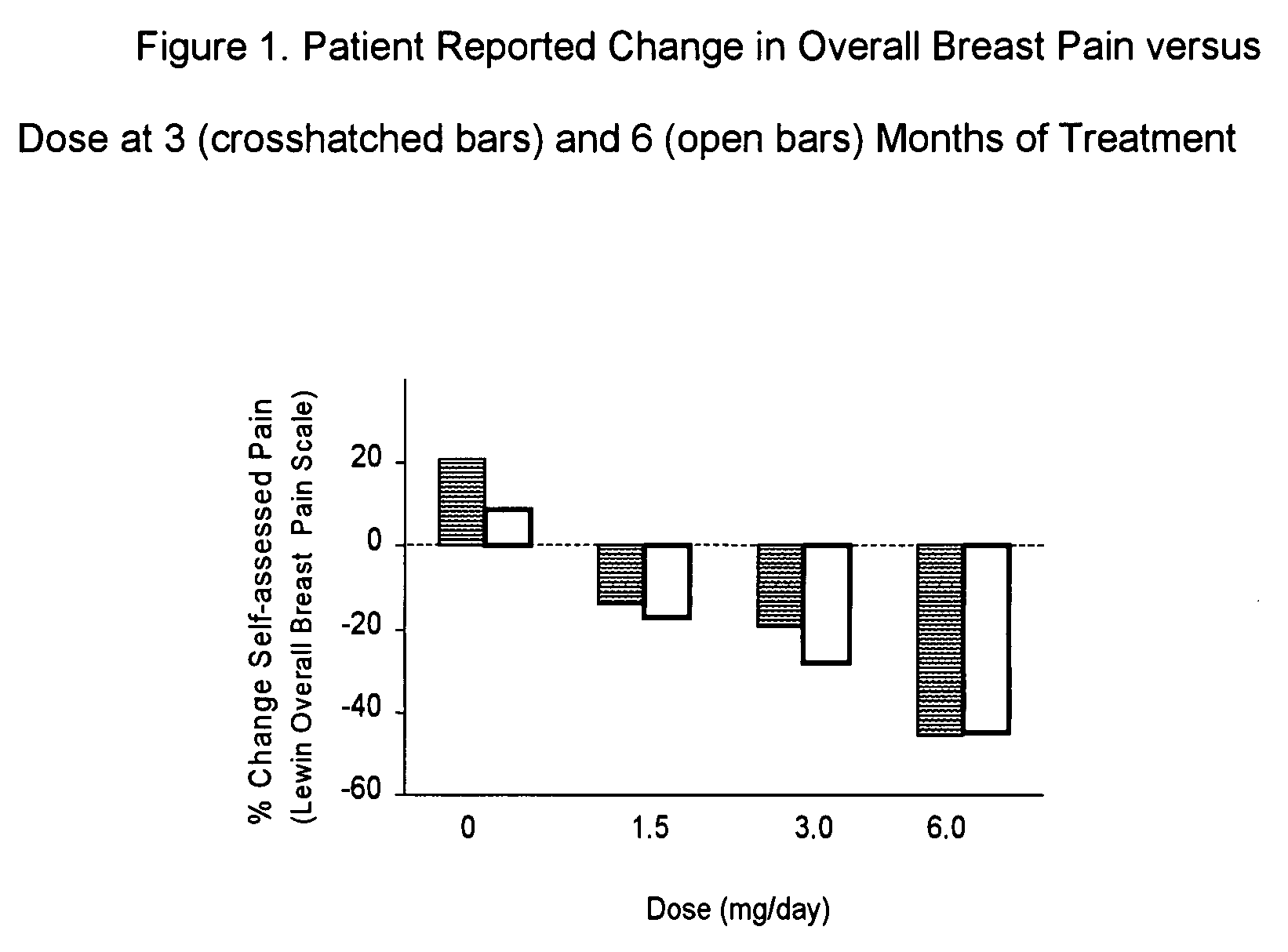Iodine therapy dosing for treating medical conditions
a technology for medical conditions and iodine therapy, which is applied in the direction of biocide, drug composition, sexual disorder, etc., can solve the problems of rapid distribution of iodine into the thyroid, which is not well understood, and achieves the effect of reducing the incidence of thyroid related findings
- Summary
- Abstract
- Description
- Claims
- Application Information
AI Technical Summary
Benefits of technology
Problems solved by technology
Method used
Image
Examples
example 1
[0045]Chronic clinical breast pain associated with fibrocystic breast tissue is a chronic condition that lasts an average of about 10 years. The condition is believed to be due to a subtle hormonal imbalance. A limited number of hormonal agents like bromocriptine, taxoxifen, danazol, etc. have demonstrated efficacy in controlled human clinical trials. Patient compliance in the treatment of chronic medical conditions is an issue; this is especially true during initiation of therapy since drugs that are effective against clinical mastalgia usually require at least 2 complete menstrual cycles to have an effect. Consequently, the initial dose of I2 Of used to treat this category of patient should provide relief within the first several months. The data contained in this example demonstrates that the majority of symptoms relief from I2 therapy can be accomplished within the first 3 months of therapy provided an adequate dose of I2 is provided.
[0046]A multi-center, randomized, double-blin...
example 2
[0049]Female patients already receiving aqueous I2 therapy for fibrocystic breast condition were enrolled in study that ran for 36 months. Patients in this study were dosed at I2 levels that ranged from 3 to 12 mg / d. A total of 923 patients were enrolled; over 700 patients remained on drug for at least 2 years. The ages of participants ranged from 17 to 78 years with an average age of 47.4 years.
[0050]Variations in treatment emergent thyroid status were evaluated based on TSH and T4 values (see Table 1). Patients were categorized sub-clinical hyperthyroid if TSH was below the normal range (0.35-5.00 mU / L) and T4 values were within the normal range (60-155 nmol / L); patients that exhibited depressed TSH and elevated T4 values were scored as overtly hyperthyroid. Patients were categorized sub-clinical hypothyroid if TSH was elevated and T4 values were normal; patients with depressed T4 values were considered overtly hypothyroid. Overt hypothyroidism occurred in 0.2% of the patients in ...
example 3
[0053]A second I2 safety study was conducted in women not previously exposed to iodine therapy (iodine naïve). This study enrolled 389 patients: placebo (n=67); 0.3 mg / d (n=66); 2.0 mg / d (n=63); 3.0 mg / d (n=66); 6.0 mg / d (n=65); and 9.0 mg / d (n=62). Thyroid functions laboratory values were available for 365 patients. The age of the female participants ranged from 20 to 55; the average age was 42.4 years. Variations in treatment emergent thyroid status were evaluated based on TSH and T4 values (see Table 2). Patients were categorized sub-clinical hyperthyroid if TSH was below the normal range (0.35-5.00 mU / L) and T4 values were within the normal range (60-155 nmol / L); patients that exhibited depressed TSH and elevated T4 values were scored as overtly hyperthyroid. Patients were categorized sub-clinical hypothyroid if TSH was elevated and T4 values were normal; patients with depressed T4 values were considered overtly hypothyroid. Overt hypothyroidism occurred in 1.3% of the patients ...
PUM
 Login to View More
Login to View More Abstract
Description
Claims
Application Information
 Login to View More
Login to View More - R&D
- Intellectual Property
- Life Sciences
- Materials
- Tech Scout
- Unparalleled Data Quality
- Higher Quality Content
- 60% Fewer Hallucinations
Browse by: Latest US Patents, China's latest patents, Technical Efficacy Thesaurus, Application Domain, Technology Topic, Popular Technical Reports.
© 2025 PatSnap. All rights reserved.Legal|Privacy policy|Modern Slavery Act Transparency Statement|Sitemap|About US| Contact US: help@patsnap.com

